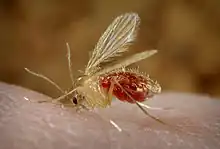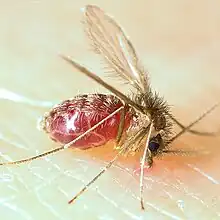Phlebotominae
The Phlebotominae are a subfamily of the family Psychodidae. In several countries, their common name is sandfly, but that name is also applied to other flies. The Phlebotominae include many genera of blood-feeding (hematophagous) flies, including the primary vectors of leishmaniasis, bartonellosis and pappataci fever. In the New World, leishmaniasis is spread by sand flies in the genus Lutzomyia, which commonly live in caves, where their main hosts are bats. In the Old World, sand flies in the genus Phlebotomus spread leishmaniasis.
| Sand flies Temporal range: Barremian[1]–Recent | |
|---|---|
 | |
| Phlebotomus papatasi | |
| Scientific classification | |
| Domain: | Eukaryota |
| Kingdom: | Animalia |
| Phylum: | Arthropoda |
| Class: | Insecta |
| Order: | Diptera |
| Family: | Psychodidae |
| Subfamily: | Phlebotominae Rondani, 1840 |
Phlebotomine females, and only females, suck blood from various mammals, reptiles and birds. Some species are selective, whereas others bite any suitable host they find. Some species can produce one clutch of eggs before their first blood meal; such females are said to practise autogenous or partly autogenous reproduction. Other species need a blood meal before they can produce any eggs at all; they are said to practise anautogenous reproduction. As far as is known, all species need a blood meal for every following clutch of eggs. Proteins and other nutrients in the blood they eat enable the female to produce the proteins and fats necessary for them to produce eggs after using up their bodily food stores.[2] In feeding on blood, the flies use their mouthparts to initiate bleeding from the host. They then suck up the exposed blood. Like practically all blood-feeding parasites, they inject biochemicals that inhibit blood clotting, plus some that stimulate host mast cells to produce histamine; this distends capillary vessels, thereby promoting blood flow.
One blood meal can support the production of about 100 eggs. Females lay their eggs in humid soil rich in organic matter. Laboratory colonies of various phlebotomine sand fly species have been established for experimental study.[3]
Sand flies are small; a body size of about 3mm in length is typical for many species, which aids them in escaping notice. Their bite is not always felt, but leaves a small round, reddish bump that starts itching hours or days later. Use of insect repellent is recommended in areas where sand flies are present.
Distribution
Phlebotomine sand flies can be found between the latitudes 50°N and 40°S, but are absent from New Zealand and the Pacific Islands.[4]
Health concerns

As sand fly females suck blood from vertebrates, including humans, they can transmit leishmaniasis, arboviruses and bartonellosis.[5]
Prevention of sand fly-borne diseases
Both sand fly sexes are found to consume plant-derived sugar meals as a source of energy, and certain plants upon which sand flies feed can shorten their life or reduce their capacity for transmitting leishmaniasis. Therefore, the structure of plant communities is found to influence the transmission dynamics of sand fly-borne diseases.
A next-generation sequencing (NGS)–based assay for determining the source of sand fly plant meals, based upon the chloroplast DNA gene ribulose bisphosphate carboxylase large chain (rbcL), found that several sand fly species, vectors of leishmaniasis in different parts of the world, prefer feeding on Cannabis sativa. The plant DNA detected in sand flies was from plant cells damaged by their mouthparts as they pierced plant tissues to reach the phloem.
Pollinator insects, including mosquitoes, are attracted to plants that emit volatile molecules such as terpene, and sixty-eight volatile compounds were detected and partially characterized in pollen and vegetative parts of Cannabis sativa by GC-MS. As cannabinoids from C. sativa exhibit antimicrobial activity against some bacteria and fungi, and a potent antileishmanial, and since thriving gut microbiomes are crucial for the development of Leishmania infections in the sand fly gut, a microbicidal effect could harm the infections.
Therefore, a novel approach for controlling blood-sucking mosquitoes and sand flies could be to exploit their plant feeding habit by utilizing attractive toxic sugar baits (ATSBs) that emit olfactory cues to attract the sand flies and mosquitoes through the addition of C. sativa plant extracts, augmenting the efficacy of ATSBs for controlling sugar-questing disease vectors.[5]
Genera
- Australophlebotomus Theodor, 1948
- Bichromomyia Artemiev, 1991
- Brumptomyia França & Parrot, 1921 (Mexico to South America)
- Chinius Leng, 1985 (2 species: China, Thailand)
- Dampfomyia Addis, 1945
- †Datzia Stebner et al.2015 (Burmese amber, Cenomanian)
- Deanemyia Galati, 1995[6]
- Evandromyia Mangabeira, 1941[7]
- Edentomyia Galati, Andrade-Filho, da Silva & Falcão, 2003 (Brazil)
- Expapillata Galati, 1995[6]
- Hertigia Fairchild, 1949
- Idiophlebotomus Quate & Fairchild, 1961
- †Libanophlebotomus Azar et al. 1999[8] Lebanese amber, Barremian
- Lutzomyia França, 1924 (North and South America)
- †Mandalayia Stebner et al.2015 (Burmese amber, Cenomanian)
- Martinsmyia Galati, 1995[6]
- †Mesophlebotomites Azar et al. 1999 Lebanese amber, Barremian
- Micropygomyia Barretto, 1962[9]
- Migonemyia Galati, 1995[6]
- Nyssomyia Barretto, 1962[9]
- Oligodontomyia Galati, 1995[6]
- †Palaeomyia Poinar 2004 Burmese amber, Albian[10]
- †Phlebotomites Stebner et al.2015 Lebanese amber, Barremian, Burmese amber, Cenomanian
- †Phlebotoiella Solórzano Kraemer and Wagner 2009 Cambay amber, India, Eocene
- Phlebotomus Rondani, 1995 & Berté, 1840 (Europe, Africa, Asia, Australia)
- Pintomyia Costa Lima, 1932
- Pressatia Mangabeira, 1942
- †Protopsychodinae Stebner et al.2015
- †Protopsychoda Azar et al. 1999 Lebanese amber, Barremian
- Psathyromyia Barretto, 1962[9]
- Psychodopygus Mangabeira, 1941[11]
- Sciopemyia Barretto, 1962[9]
- Sergentomyia França & Parrot, 1920 (Europe, Africa, Asia, Australia)
- Trichophoromyia Barretto, 1962[9]
- Viannamyia Mangabeira, 1941[12]
- Warileya Hertig, 1948 (Central and South America)
Gallery: anatomy of Phlebotominae
.png.webp) Head
Head.png.webp) Head
Head.png.webp) Mouth parts
Mouth parts.png.webp) Mouth parts
Mouth parts.png.webp) Mouth parts
Mouth parts.png.webp) Mouth parts
Mouth parts.png.webp) Mouth parts
Mouth parts.png.webp) Mouth parts
Mouth parts.png.webp)
.png.webp) Thorax
Thorax.png.webp) Thorax
Thorax.png.webp) Thorax
Thorax.png.webp) Thorax
Thorax.png.webp) Wing
Wing.png.webp) Abdomen
Abdomen.png.webp) Abdomen
Abdomen.png.webp) Abdomen
Abdomen.png.webp) Genitalia
Genitalia.png.webp) Genitalia
Genitalia.png.webp) Genitalia
Genitalia.png.webp) Genitalia
Genitalia.png.webp) Genitalia
Genitalia.png.webp) Genitalia
Genitalia.png.webp) Genitalia
Genitalia.png.webp) Genitalia
Genitalia.png.webp) Genitalia
Genitalia.png.webp) Genitalia
Genitalia.png.webp) Genitalia
Genitalia
See also
References
- Azar, Nel, Solignac, Paicheler, Bouchet. "New genera and species of psychodoid flies from the Lower Cretaceous amber of Lebanon". Palaeontology.
- Braverman, Y. Nematocera (Ceratopogonidae, Psychodidae, Simuliidae and Culicidae) and control methods Rev. sci. tech. Off. int. Epiz., 1994,13(4), 1175-1199
- Lawyer, Phillip; Killick-Kendrick, Mireille; Rowland, Tobin; Rowton, Edgar; Volf, Petr (2017). "Laboratory colonization and mass rearing of phlebotomine sand flies (Diptera, Psychodidae)". Parasite. 24: 42. doi:10.1051/parasite/2017041. PMC 5687099. PMID 29139377.

- Killick-Kendrick R. (1999). "The biology and control of Phlebotomine sand flies". Clinics in Dermatology. 17 (3): 279–89. doi:10.1016/S0738-081X(99)00046-2. PMID 10384867.
- Abbasi, Ibrahim; Trancoso Lopo de Queiroz, Artur; Kirstein, Oscar David; Nasereddin, Abdelmajeed; Horwitz, Ben Zion; Hailu, Asrat; Salah, Ikram; Mota, Tiago Feitosa; Fraga, Deborah Bittencourt Mothé (2018-11-13). "Plant-feeding phlebotomine sand flies, vectors of leishmaniasis, prefer Cannabis sativa". Proceedings of the National Academy of Sciences of the United States of America. 115 (46): 11790–11795. Bibcode:2018PNAS..11511790A. doi:10.1073/pnas.1810435115. ISSN 0027-8424. PMC 6243281. PMID 30373823.
- Galati, E.A.B. (1995). "Phylogenetic systematics of Phlebotominae (Diptera) with emphasis on American groups". Boletín de Dirección de Malariologia y Ssaneamiento Ambiental. 35 (Suplemento 1): 133–142.
- Mangabeira, O. (1941). "3a contribuição ao estudo dos Flebotomus. Evandromyia n. subg. (Diptera: Psychodidae)". Memórias do Instituto Oswaldo Cruz. 36: 215–233. doi:10.1590/S0074-02761941000200003.
- Azar, D.; Nel, A.; Solignac, M.; Paicheler, J.-C.; Bouchet, F. (1999). "New genera and species of psychodoid flies from the Lower Cretaceous amber of Lebanon". Palaeontology. 42 (6): 1101–1136. doi:10.1111/1475-4983.00112. S2CID 84535813.
- Barretto, M.P. (1962). "Novos subgeneros de Lutzomyia Franca, 1924 (Diptera, Psychodidae, subfamilia Phlebotominae)". Revista do Instituto de Medicina Tropical de São Paulo. 4: 91–100.
- Poinar Jr, George. "Palaeomyia burmitis gen. n., sp. n.(Phlebotominidae: Diptera) a new genus of Cretaceous sandflies with evidence of blood sucking habits". Proceedings of the Entomological Society of Washington.
- Mangabeira, O. (1941). "4a contribuição ao estudo dos Flebotomus. Psychodopygus n. subg. (Diptera: Psychodidae)". Memórias do Instituto Oswaldo Cruz. 36 (3): 237–250. doi:10.1590/S0074-02761941000300001.
- Mangabeira, O. (1941). "5a contribuição ao estudo dos Flebotomus. Viannamyia n. subg. (Diptera: Psychodidae)". Memórias do Instituto Oswaldo Cruz. 36 (251–262).
External links
- Galati, Eunice A. B.; Galvis-Ovallos, Fredy; Lawyer, Phillip; Léger, Nicole; Depaquit, Jérôme (2017). "An illustrated guide for characters and terminology used in descriptions of Phlebotominae (Diptera, Psychodidae)". Parasite. 24: 26. doi:10.1051/parasite/2017027. ISSN 1252-607X. PMC 5520390. PMID 28730992.

- Depaquit, Jérôme; Pesson, Bernard; Augot, Denis; Hamilton, James Gordon Campbell; Lawyer, Phillip; Léger, Nicole (2016). "Proceedings of the IX International Symposium on Phlebotomine Sandflies (ISOPS IX), Reims, France, June 28th–July 1st, 2016". Parasite. 23: E1. doi:10.1051/parasite/2016051. PMC 5047050. PMID 27677701.

- CIPA Computer-aided Identification of Phlebotomine sand flies of America
- Lutzomyia shannoni, a sand fly on the UF / IFAS Featured Creatures website